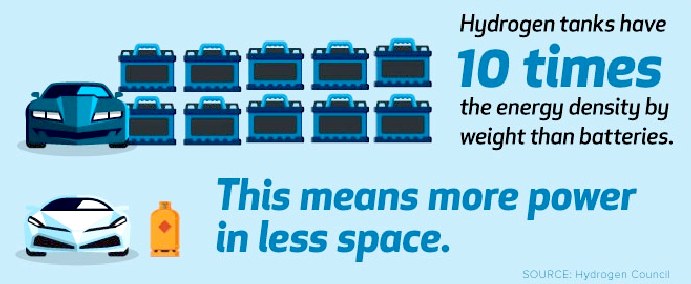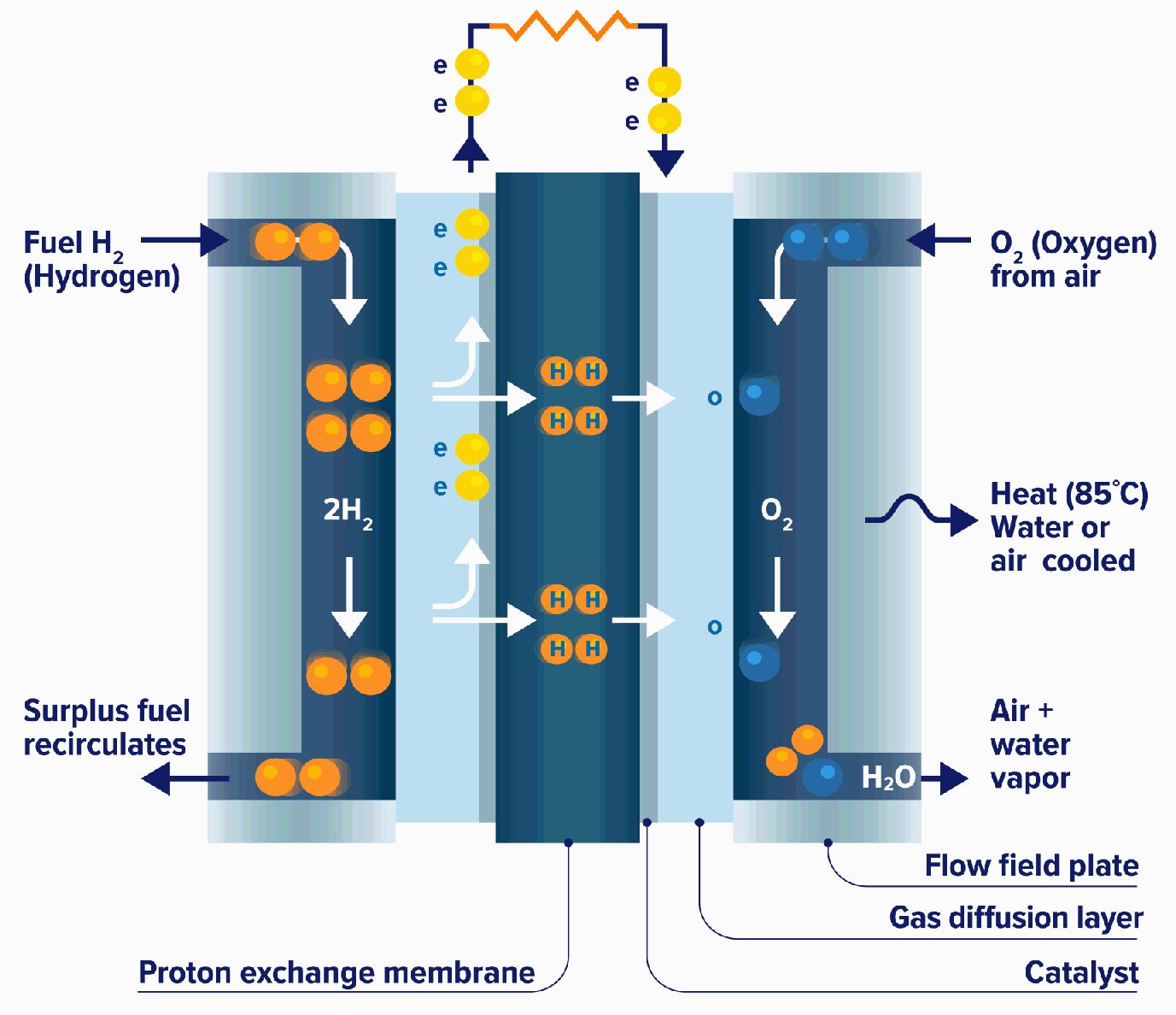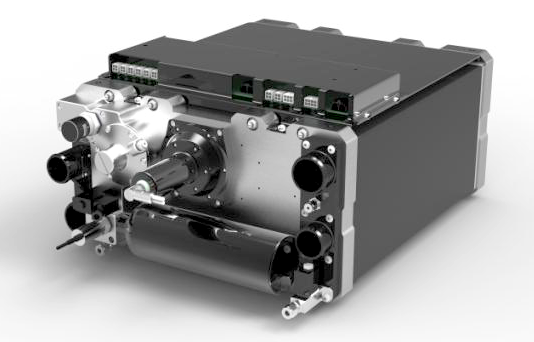|

Though
the energy density is greater for hydrogen, you then need to add the weight
of a fuel cell stack, which detracts from the apparent energy density.
Conventional batteries include the conversion mechanism.
Hydrogen
powered vehicles offer particulate free transport for cities where diesel
engines are choking the population and causing lung
cancer. There is an abundance
of clean wind and
solar energy that can produce
green
hydrogen, something
that at the moment is not happening, but will accelerate as EVs become
cheaper.
According
to a press release dated 29 April 2019 – Bosch has entered the market for mobile fuel cells
to pave the way for the breakthrough of this technology in trucks and cars. One crucial component here is the stack. As the core of the fuel cell, is converts hydrogen into electrical energy. To further improve and manufacture these stacks, Bosch has now formed an alliance with Powercell Sweden AB, the Swedish manufacturer of fuel-cell stacks. Under the agreement, the two partners will work jointly to make the polymer-electrolyte membrane (PEM) fuel cell ready for production. Bosch will then manufacture this technology under license for the global automotive market. The stack will complement the Bosch portfolio of fuel-cell components, and is to be launched in 2022 at the latest. “In the fuel-cell domain, Bosch already has a strong hand, and the alliance with Powercell makes it even stronger. Commercializing technology is one of our strengths. We are now going to take on this task with determination and develop this market,” says Dr. Stefan Hartung, member of the Bosch board of management and chairman of the Mobility Solutions business sector. Over the long term, the mobile fuel-cell business is potentially worth billions of euros for Bosch. It estimates that as much as 20 percent of all electric vehicles worldwide will be powered by fuel cells by 2030. “With the combined weight of its clout and expertise, Bosch will provide our fuel-cell technology with the chance to gain a foothold in the automotive market. We couldn’t imagine a better partner than Bosch for this,” says Per Wassén, the Powercell CEO.
Fuel-cell technology for trucks and cars
Bosch believes the best opportunities for broad adoption of fuel-cell technology are in the commercial-vehicle market. The EU’s fleet requirements for trucks call for a reduction of CO₂ emissions by 15 percent on average by 2025, and 30 percent by 2030. Bosch’s view is that this target can only be reached by electrifying more and more of the powertrain. The fuel cell can play a decisive role here. Once they have become established in trucks, Bosch fuel-cell powertrains will then increasingly find their way into passenger cars. But for this to happen, the cost of fuel-cell systems needs to be progressively reduced. The biggest cost item is the stack. It accounts for nearly two-thirds of the total cost of a fuel-cell system. “Through commercialization and widespread marketing of this technology, Bosch will achieve economies of scale and push down costs,” Hartung says. Costs also have to fall when it comes to hydrogen. Currently, this fuel is mainly produced for industrial applications, at a kilogram price that frequently exceeds five euros. As production grows, the price should fall. One kilogram of hydrogen contains as much energy as about three liters of diesel. For 100 kilometers, a modern 40-ton truck requires seven to eight kilograms of hydrogen.
Bosch as a systems supplier with a broad portfolio
It is uses green electricity, the production of hydrogen can be climate-neutral. Various industrial enterprises are working to perfect this process. In addition, there is a small network of more than 60 hydrogen filling stations in Germany, and this number is set to rise. The hydrogen tank can be refilled with highly compressed gas in a matter of minutes. In the fuel cell (or fuel-cell stack as an assembly of such cells is called) the hydrogen reacts with oxygen. The end result – apart from water as a by-product – is electrical energy. This can be used either to recharge a battery in the vehicle or to directly power the electric motor. By flexibly combining two or more stacks, the power requirements of all kinds of vehicles can be covered, from passenger cars to heavy trucks. With its 60 associates, Powercell is gradually moving from manual production of fuel cell stacks to ramp-up of a semi-automatic production. Powercell has developed cutting edge fuel cell technology and its stacks provide an output of up to 125 kilowatts. Headquartered in Göteborg, Sweden, the company was spun off from the Volvo Group in 2008. It already supplies fuel cells for use as prototypes in trucks and cars. Bosch also has a lot of expertise in fuel-cell technology. The supplier of technology and services sees itself as a systems supplier, and already has a broad portfolio of components for fuel cells in trucks and cars. These include an air compressor with power electronics and a control unit with sensors.
Further alliance for stationary fuel cells
As well as PEM fuel cells, Bosch is already actively involved in solid-oxide fuel cells (SOFC). Since the middle of last year, Bosch has been working with the the British specialist Ceres Power to further improve SOFC technology for applications such as distributed power supplies to factories and computing centers. The idea behind the technology is to have small power stations set up throughout cities, as well as in industrial areas. Because these standardized plants are highly flexible, they will be able to cover peak demand better than conventional plants. The aim is for one SOFC module to generate 10 kilowatts of electrical power. Where more electricity is needed, any number of modules with the same output can simply be interconnected. 
All
commercial fuel cells have a
similar basic configuration, an electrolyte, permeable membrane and two electrodes, but there are different types of
fuel cells based mainly on what electrolyte they use.
Fuel cells are stacked and wired in series (just like lithium batteries)
to raise the operating voltage. CONTACTS Robert Bosch GmbH
Corporate Communications – External Communications
Postfach 10 60 50
70049 Stuttgart
Executive Vice President - Prof. Dr. Christof Ehrhart
Corporate Department Communications and Governmental Affairs
Christof.Ehrhart@de.bosch.com
Melita Delic - Head of External Communications, spokesperson Bosch Group
+49 711 811-48617 melita.delic@de.bosch.com
Trix Boehne - Spokesperson corporate, business, political issues
+49 30 32788-561 trix.boehne@de.bosch.com
Sven Kahn - Spokesperson corporate, finances
+49 711 811 6415 Sven.Kahn@de.bosch.com
Irina Ananyeva - Spokesperson international topics
+49 1525 9753284 Irina.Ananyeva@de.bosch.com
Simon Schmitt - Spokesperson personnel and social topics, IT
+49 711 811-6478 simon.schmitt@de.bosch.com
Nora Katharina Lenz-Gaspary - Spokesperson personnel and social topics
NoraKatharina.Lenz-Gaspary@de.bosch.com
Inga Ehret - Spokesperson internet of things (AIoT) and corporate responsibility
+49711 - 811 - 16476 inga.ehret@de.bosch.com
LINKS
& REFERENCE
https://www.bosch-presse.de/pressportal/de/en/bosch-to-cooperate-in-large-scale-production-of-fuel-cells-for-trucks-and-cars-188480.html

Please
use our A-Z
INDEX to navigate this site
This
website is provided on a free basis to
promote zero emission transport in Europe and Internationally. Copyright © Climate Change Trust 2022. Solar
Studios, BN271RF, United Kingdom.
|


